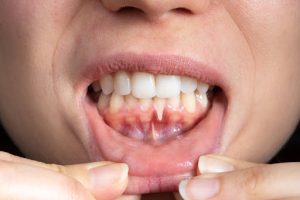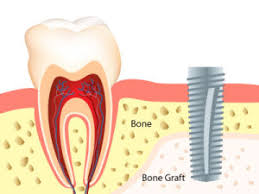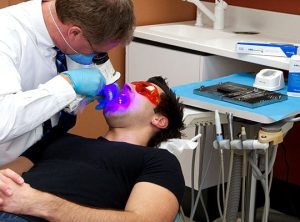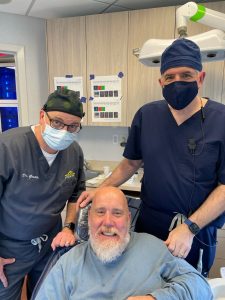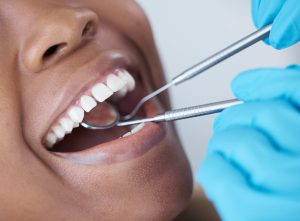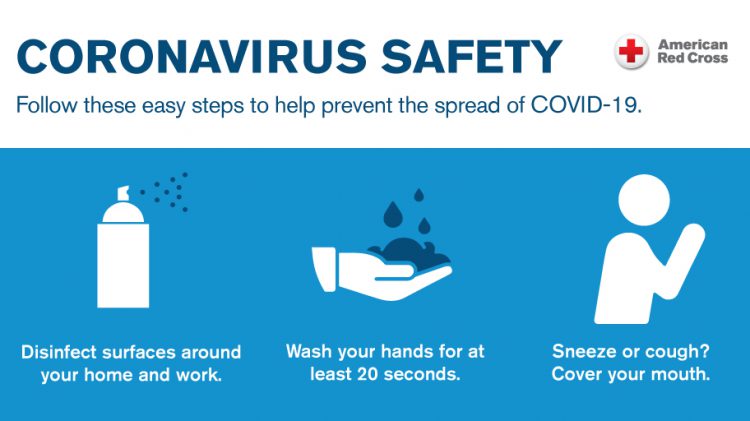Benefits of Holistic Dentistry for Gum Disease Treatment
Holistic Dentistry Near You In the bustling communities of Long Island, where residents in Medford, Hauppauge, and surrounding areas prioritize both oral health and overall wellness, holistic dentistry stands out as a transformative approach to periodontal care. At the Farber Center for Periodontics & Dental Implants, we integrate holistic principles with advanced periodontal treatments to address gum disease and provide superior dental implant solutions. Unlike traditional dentistry, which focuses solely on symptoms, holistic dentistry views your mouth as a gateway to whole-body health, considering factors like nutrition, lifestyle, and biocompatible materials to promote lasting recovery. If you're looking for holistic...
Read MorePeriodontal Risk Management: A Chairside Playbook for Your Patients
Why This Matters: Periodontal risk assessment helps us predict disease, intervene earlier, and lower the total burden of inflammatory illness. The latest review underscores a practical, chairside approach that links oral findings with systemic risks - and makes referral timing clearer. Key Takeaways for Your Practice: Risk is multidimensional. Periodontal status reflects modifiable habits (e.g., tobacco, vaping), systemic disease control (diabetes, CVD, CKD) and life stage (pregnancy, aging). Bidirectional links are real. Periodontitis can worsen glycemic control and may influence cardiovascular, respiratory, renal and neuroinflammatory conditions. Early, targeted intervention wins. Brief chairside risk screens and tailored hygiene/behavioral counseling improve healing...
Read MoreThe Connection Between Smoking and Gum Disease
Our Long Island Periodontists Offer Gum Disease Treatments At our state-of-the-art dental practice, we’re committed to helping Long Island residents achieve optimal oral health. One critical topic we frequently discuss with our patients is the strong link between smoking and gum disease. Whether you’re a smoker, a vaper, or someone exposed to secondhand smoke in Nassau or Suffolk Counties, understanding this connection is vital for protecting your smile and overall wellness. Our Long Island periodontists are here to help if you’re suffering from any stage of gum disease. If you’re looking to schedule an appointment, contact our Medford dental office...
Read MoreFailing Dental Implant Symptoms
Our Periodontist Near You Can Help with Dental Implant Failure At Farber Center for Periodontics & Dental Implants, we’ve been transforming smiles across Long Island for decades. Founded by Dr. Alan Farber, a trailblazer in periodontal care, our dental practices in Hauppauge and Medford, NY, are led by board-certified periodontists Dr. Alan Farber, Dr. Vasiliki Batalias, and Dr. Chris Chondrogiannis. Renowned for our patient-centric approach, innovative techniques, and commitment to excellence, we specialize in periodontal care, dental implants, and, when needed, failing dental implant treatment. Whether you're considering new dental implants from our Long Island periodontists near you or in...
Read MoreS.M.A.R.T. Grafting & Full Mouth Rehabilitation
The Role of Bone Grafting in Full Mouth Reconstruction: Why S.M.A.R.T. Is a Game Changer Full mouth reconstruction is a comprehensive treatment designed to restore both function and aesthetics for individuals experiencing extensive tooth loss, severe decay, or jawbone deterioration. These procedures help patients regain the ability to chew, speak, and smile with confidence. However, a strong and healthy jawbone is often essential for the long-term success of restorative treatments such as dental implants. At Farber Center for Periodontics & Dental Implants, our Long Island periodontists utilize advanced techniques such as S.M.A.R.T. bone grafting to rebuild lost bone with minimal...
Read MoreWhy Be a Patient at Farber Center?
At Farber Center, we’re dedicated to providing exceptional periodontal care in a welcoming and comfortable environment. Led by Dr. Alan Farber, Dr. Chris Chondrogiannis, and Dr. Vasilicki Batalias, our team combines expertise, compassion, and cutting-edge technology to deliver outstanding results for our patients. Here’s what makes Farber Center the right choice for your dental care: Meet Our Experts Our doctors bring years of specialized training and experience to every patient’s care: Dr. Alan Farber: A leader in periodontal care, Dr. Farber has achieved instructor status in laser dentistry through the prestigious Institute of Advanced Laser Dentistry (IALD). Dr. Chris Chondrogiannis:...
Read More10 Signs Your Gums Might be in Trouble
Improve Your Gum Health with Our Trusted Periodontists in Long Island Your gums are the foundation of your oral health, yet they’re often overlooked until there’s a problem. At Farber Center for Periodontics and Dental Implants, we understand the importance of maintaining healthy gums to ensure a healthy, confident smile. Led by Dr. Farber, a highly experienced periodontist, our dental practices specialize in identifying and treating gum issues before they become severe. It’s time to pay close attention to these 10 warning signs of gum trouble. If you’re looking for a periodontist in Long Island, contact our dental practices today!...
Read MoreAre Your Dental Implants Failing?
Failing Dental Implant? Our Long Island Periodontist Can Help Dental implants are an excellent solution for replacing missing teeth, offering durability, functionality, and a natural appearance. However, like any medical procedure, dental implants aren’t entirely immune to complications. If you’re experiencing discomfort or issues with your dental implants, you may wonder if they're failing. At the Farber Center for Periodontics and Dental Implants, Dr. Farber and his team are here to help you understand the signs of implant failure and provide effective solutions to save your smile. If you think you're dealing with dental implant failure, contact our Long Island...
Read MoreWhy You Should Get Teeth Cleanings Every Three Months
The Importance of Professional Teeth Cleaning Every Three Months Maintaining good oral hygiene is vital for health and well-being. While daily brushing and flossing are essential components of oral care, they may not be sufficient to prevent the buildup of plaque and tartar. Professional teeth cleaning, performed by a dental hygienist, plays a crucial role in keeping your teeth and gums healthy. The Long Island Periodontists of Farber Center For Periodontics & Dental Implants delve into the reasons why patients should consider having their teeth professionally cleaned every three months as opposed to the standard twice a year. Prevention of...
Read MoreThe Link Between Oral Health and Overall Well-being
The link between oral health and overall well-being, including physical and spiritual aspects, is a complex and interconnected relationship. While it's important to note that scientific evidence may vary in terms of the strength of these connections, there are several ways in which oral health can impact general well-being: 1. Physical Health: Systemic Health: Oral health is linked to systemic health, and poor oral hygiene has been associated with various systemic conditions such as cardiovascular disease, diabetes, and respiratory infections. Bacteria in the mouth can enter the bloodstream and contribute to inflammation in other parts of the body. Nutrition: The...
Read MoreWhy Oral Hygiene Is Crucial to Your Overall Health – By Hannah Seo
By Hannah Seo April 6, 2023 The inside of your mouth is the perfect place for bacteria to thrive: It’s dark, it’s warm, it’s wet and the foods and drinks you consume provide nutrients for them to eat. But when the harmful bacteria build up around your teeth and gums, you’re at risk of developing periodontal (or gum) disease, experts say, which is an infection and inflammation in the gums and bone that surround your teeth. And such conditions in your mouth may influence the rest of your body, said Kimberly Bray, a professor of dental hygiene at the University...
Read MoreHow Is Periodontal Disease Connected with Whole Body Health
Periodontal disease, also known as gum disease, is a chronic inflammatory condition that affects the supporting structures of the teeth, including the gums, periodontal ligaments, and bone. Research has shown that periodontal disease is not just confined to the oral cavity; it can also have implications for overall health. The connection between periodontal disease and whole body health is often referred to as the oral-systemic link. Here are some ways in which periodontal disease is connected to whole body health: 1. Inflammation: Periodontal disease is characterized by inflammation in the gums. Chronic inflammation in the body has been linked to...
Read MoreThe Vital Connection: Water and Staying Hydrated for Gum Disease Prevention
Prevent gum disease this summer, stay hydrated! Prevent gum disease this summer, stay hydrated! Good oral health is crucial, and seeking treatment from a periodontist in Medford and Hauppauge is vital in maintaining optimal gum health. However, did you know that something as simple as water and proper hydration can significantly impact gum disease prevention and management? At Farber Center for Periodontics & Dental Implants, your periodontist in Medford and Hauppauge has a few tips for staying hydrated to help protect you from gum disease and improve your overall health. What is Gum Disease? Gum disease, also known as...
Read MoreInnovations in Gum Disease Treatment
Innovations in Periodontal Treatment Recent advancements have made gum disease treatment less invasive and better than ever. Periodontal disease, or gum disease, affects millions of people worldwide. It’s a very common condition that can lead to tooth loss and other serious health problems if it’s left untreated. Fortunately, at Farber Center for Periodontics and Dental Implants, we have several innovations in periodontal treatment that are non-invasive and can greatly benefit you. Laser Therapy Laser therapy, often called LANAP or laser-assisted new attachment procedure is a great non-invasive treatment for gum disease. It’s a quick and painless procedure that is...
Read MoreSuccessful Treatments for Advanced Gum Disease on Long Island
Your periodontist near you can help with advanced gum disease treatment. If you are one of the millions of people that suffer from advanced periodontal or gum disease, you know how frustrating and embarrassing it can be. Advanced gum disease is a common oral health issue caused by the buildup of plaque and tartar that irritates and inflames the gums. This inflammation and irritation lead to the progressive destruction of the supporting structures of the teeth. This looks like deep pockets between the teeth and gums, loose teeth, and eventual tooth loss. Even if you have tried several treatments that...
Read MoreWhat Does a Periodontist in Long Island Do?
A periodontist is a dental specialist who focuses on the treatment and maintenance of the structures that support the teeth, including the gums, bones, and ligaments. This type of dentist is specially trained to diagnose, treat and prevent periodontal or gum disease. To become a periodontist, you must first complete a four-year undergraduate degree and then attend dental school for an additional four years. After graduation from dental school, a periodontist must complete two more years of advanced training in periodontology. This training includes coursework and hands-on experience in the diagnosis and treatment of periodontal disease and other related conditions....
Read More


